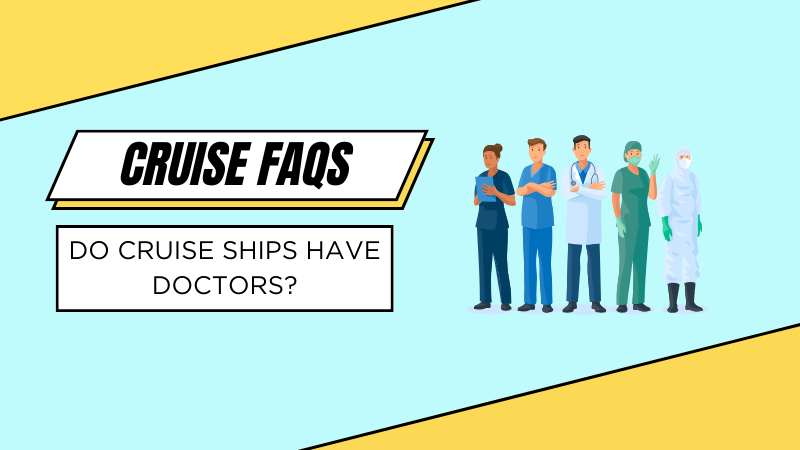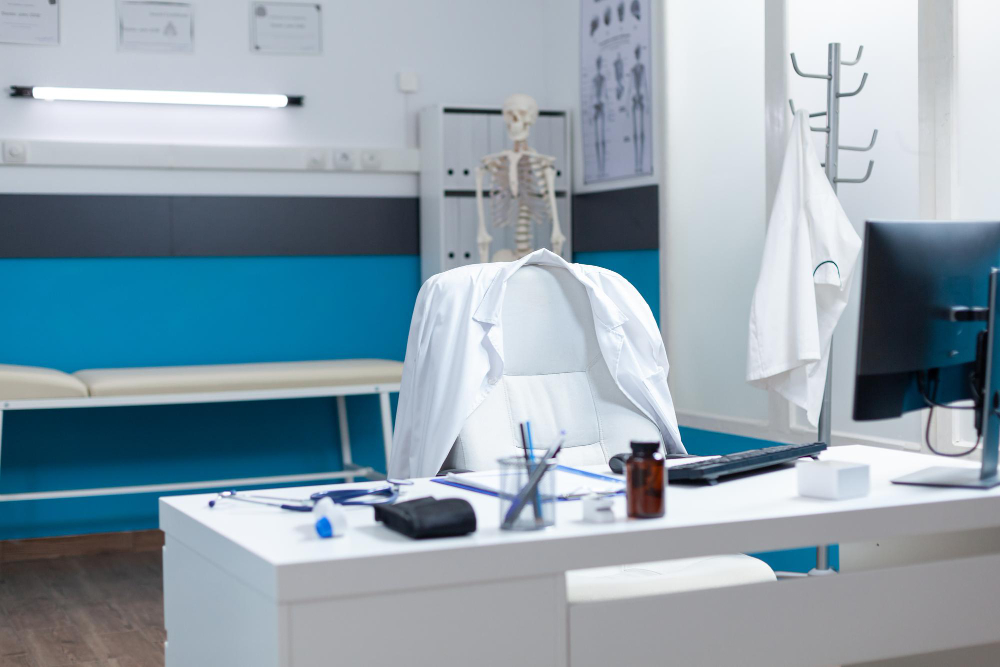Boarding a cruise ship brings with it the excitement of the sea, but have you ever wondered what happens if someone falls ill onboard? The recent COVID-19 pandemic has starkly highlighted the need for robust healthcare systems in these floating cities.
Take P&O Cruises, for example. They’ve ramped up their health protocols, ensuring their medical centers are equipped and ready 24/7, with qualified staff to handle everything from seasickness to more serious concerns.
In this article, I will guide you through the healthcare services aboard a cruise ship. We’ll dive into the facilities available, the expertise of the medical staff, and how cruising giants have adapted to keep us safe in turbulent times.
Do Cruise Ships Have Doctors?
One of the most common questions I get asked about cruise life is, “Do ships have doctors?” The answer is a resounding yes, and the level of care they provide is more comprehensive than you might expect. The medical standards on cruise ships, particularly those operating from the U.S., are rigorous.
The American College of Emergency Physicians, alongside the Cruise Lines International Association, lays down stringent guidelines for both the medical personnel and the facilities onboard. This ensures a high level of care, similar to what you’d find in many land-based medical facilities.
Doctor Qualifications
The qualifications of cruise ship doctors are particularly impressive. Under the ACEP standards, they must have at least three years of post-graduate experience in fields like general and emergency medicine, or be board-certified in specialties such as advanced life support practices, medical emergencies, family, minor surgical procedures, or internal medicine. They’re also required to be certified in advanced cardiac life support.
Pediatric Care
For ships carrying children under 12, there’s an additional layer of care required. At least one physician is required to have pediatric training or equivalent emergency training involving kids, ensuring that our youngest cruisers are in safe hands in the ship’s medical center.
Beyond the cruise ship doctor, the medical team includes highly trained nurses, often with paramedic experience. All nurses are experienced registered nurses, forming a robust team ready to tackle a range of medical needs.
On-Board Facilities
Many larger cruise ships, like those operated by Princess Cruises, have hospital-like treatment rooms within their onboard medical centers. The size of the medical team varies with the ship’s size – the largest vessels may have two doctors and up to six nurses. Smaller river ships, staying close to shore, may have fewer staff, relying on easy access to land-based facilities in emergencies.
All medical practitioners, including doctors and nurses, are accountable to a chief medical officer stationed at the cruise line’s central office, who is available round the clock to assist in case of emergencies.
On my very first cruise, I remember being pleasantly surprised to discover the extent of medical facilities onboard. The infirmary, usually tucked away on a lower deck, is a hub of medical expertise. While it typically operates during regular hours, as listed in the ship’s daily program, the medical staff is always on call for emergencies, ensuring round-the-clock care.
Walking into the infirmary is much like entering any doctor’s office. There’s a waiting room where you fill out medical history forms before heading to one of the exam rooms. In my experience, the staff is as professional and thorough as any land-based clinic.
It’s only in more serious medical situations that you’re taken to the separate area housing hospital beds, a small surgical suite for minor surgeries, or the ICU and isolation rooms. Thankfully, I’ve never needed these services, but it’s reassuring to know they’re there.
The equipment in these shipboard medical centers is impressive. Onboard, you will typically find cardiac monitors, defibrillators, ventilators, x-ray machines, oxygen tanks, and even laboratory equipment. On some Carnival Cruise Line ships, for instance, there’s advanced technology like thrombolytic therapy for blood clots and pulse oximetry for oxygen level testing.
Carnival Cruise Line‘s medical facilities have specific hours:
On the day the ship embarks, they’re open from 8 to 9 a.m. and 3 to 5 p.m. On sea days, the facilities are open from 9 a.m. to noon and 3 to 6 p.m., while on port days, their hours are from 8 to 10 a.m. and 4 to 6 p.m. This ensures medical care is accessible to all passengers, regardless of the day’s activities.
Pharmacies On Cruise
When seasickness hit me unexpectedly, I was relieved to find that the ship had its own well-stocked medical facility, equipped to provide immediate relief.
Onboard pharmacies carry a surprising variety of medicines, ensuring passengers have access to essential medications for common health issues. The inventory, which varies by ship, includes everything from antibiotics and seasickness pills (often complimentary) to aspirin and other over-the-counter drugs.
These pharmacies are well-equipped to cater to a diverse array of medical requirements, maintaining a supply of medications for cardiovascular and gastrointestinal ailments, infectious diseases, respiratory conditions, and even vaccines. Whether you’re dealing with a minor ailment or something more significant, there’s a high chance the pharmacy can help.
While the convenience is unmatched, it’s worth noting that the cost of medications on board can be higher than your home pharmacy, but generally comparable to prices you’d find if you purchased them in a port. This includes seasickness medications, which are readily available and can be a lifesaver for those who are unsure if they’ll be affected by motion sickness. This is a small price to pay for the convenience and peace of mind provided by these pharmacies.
Having this resource at hand on a cruise ship reassures passengers that their health and comfort are taken seriously, making for a safer and more enjoyable journey.
Common Medical Issues Handled on Cruise Ships
I’ve seen firsthand how the medical team on cruise ships expertly handles common health concerns. According to the World Health Organization, the most common issues are respiratory and gastrointestinal illnesses, like influenza and norovirus. They also skillfully manage cases of motion sickness and various injuries.
It’s important to understand that a ship’s medical facility is more of an infirmary than a full-fledged hospital. This means while they’re equipped for a range of medical situations, they’re not designed for highly complex medical procedures. The staff’s expertise in quickly addressing these common issues is truly commendable, ensuring that passengers get the care they need to continue enjoying their journey.
Procedures for Handling Emergencies and Serious Medical Conditions.
Cruising is generally a smooth experience, but it’s comforting to know that if a medical emergency arises, the cruise ship doctors and the team on board are well-prepared. This is particularly reassuring for seniors who are on a cruise and may have concerns about health care while traveling. Most medical issues on ships are routine, yet the team is adept at providing life support services and stabilizing anyone seriously ill.
In cases where a patient needs more intensive care than the ship can provide, medivac procedures come into play. The patient would typically be medically disembarked at the next port and transferred to a hospital on a stretcher.
But, if a critical emergency occurs at sea, the U.S. Coast Guard, or the local equivalent overseas, is ready to assist, even airlifting patients if necessary. It’s a bit sobering, but ships are equipped with morgue facilities too, just in case. This level of preparedness is part of adhering to the American College of Emergency Physicians’ standards.
Cruise lines have clear policies on when passengers should be medically disembarked. The medical team aboard the ship possesses the authority to determine whether a passenger is not fit to continue their journey at sea. For instance, as MSC Cruises outlines, passengers are disembarked if their condition could endanger their health or safety.
These decisions are always made with the passenger’s well-being in mind. It’s important to emphasize that air evacuation is exclusively reserved for the most critical cases. This procedure introduces additional physical and emotional strain, and the medevac units are manned by highly trained medics specializing in emergency treatment.
Case Studies or Examples of Medical Incidents Handled at Sea
Let me share a story from one of my cruises that stuck with me. Everyone was soaking up the sun, some by the pool, others with a book in hand. That’s when something unexpected happened.
Out of nowhere, a fellow passenger, an older gentleman enjoying his time by the pool, suddenly slumped over. It was one of those moments that made your heart skip a beat. But what happened next was truly remarkable.
The medical team, they were like superheroes in disguise. They appeared almost instantly, maneuvering through the crowd with a stretcher and a medical bag. Their efficiency and calmness amidst the sudden rush of worried onlookers were incredible.
They quickly got to work, checking the gentleman’s vital signs, and administering first aid. It was like watching a well-choreographed dance, each move precise and confident. The way they handled the situation, with such professionalism and care, it was reassuring to know that we were in safe hands.
In less than an hour, the gentleman was stabilized and taken to the infirmary for further observation. The whole incident was a powerful reminder of the unexpected turns life can take, even in the middle of the ocean, and the importance of having a competent medical team on board. It’s these behind-the-scenes heroes that make cruising not just enjoyable, but safe for everyone.
How Passengers Can Access Medical Care on Board
Ever wondered how you can get medical help while cruising? It’s simpler than you might think. On a cruise, if you ever need medical attention, here’s how it works.
To begin, it’s common to find the medical center situated on a lower deck of the cruise ship. This is a strategic choice – away from the hustle and bustle of crowded areas and conveniently close to crew facilities. This arrangement is especially reassuring for solo travelers over their 50s, who can feel confident about accessing medical services easily, regardless of the time of day.
It ensures privacy and easy access, both for passengers and crew. What’s great about these medical centers is that they cater to everyone on board – passengers and crew alike. So, whether it’s a minor ailment or something more serious, the medical team is there to help.
Now, while the medical team is on call 24/7 for emergencies, for regular visits, you’ll want to go during their scheduled hours. These hours are usually listed in the ship’s daily program, so it’s easy to plan your visit. Just drop in during these times, and you’ll get the care you need.
Costs and Insurance Considerations for Medical Care at Sea
When it comes to medical care at sea, it’s essential to be prepared for potential costs. Treatment and medications provided by ship physicians are usually charged to your cabin account, often requiring immediate out-of-pocket payment. Cruise ship doctors, who typically operate as independent contractors, may charge an hourly fee, with additional costs for any medications or tests.
This is where travel insurance becomes invaluable. Generally costing between 5 and 8 percent of your trip’s total price, it can cover most cruise ship medical expenses incurred onboard. Opting for travel insurance and preferably health insurance offers peace of mind, ensuring you’re financially protected against unexpected medical costs during your cruise.
Conclusion
The COVID-19 pandemic brought unprecedented challenges to the cruising world, leading to significant enhancements in onboard medical services. This included regular health screenings, isolation wards for suspected cases, and enhanced sanitation measures. Witnessing this swift adaptation and commitment to passenger health was both reassuring and impressive
These changes underline the importance and availability of comprehensive medical care on cruise ships. From routine ailments to emergency responses, the medical teams are equipped to handle a spectrum of health issues, ensuring the safety and well-being of every passenger and crew member.
As we look forward to more adventures at sea, it’s comforting to know that the industry’s response to health crises like COVID-19 has made cruising safer than ever. With well-stocked pharmacies, capable medical staff, and enhanced health protocols, cruise lines have demonstrated a steadfast commitment to ensuring a safe and healthy experience for all.
So, as you set sail on your next cruise, rest assured that your health and safety are in capable hands, letting you fully enjoy the wonders of the sea with peace of mind.
FAQs
Do cruise ships have real doctors?
Cruise ships are equipped with fully qualified doctors who provide medical services to passengers and crew. These medical professionals are licensed physicians capable of addressing various health concerns while at sea. Additionally, in the rare event of a fatality, cruise ships are prepared with onboard morgues to respectfully and appropriately handle such situations until the ship reaches port.
Can cruise ship doctors prescribe antibiotics?
Cruise ship doctors can prescribe antibiotics when appropriate. They can diagnose and treat illnesses, including bacterial infections, to ensure passengers’ well-being during their voyage.
How much do cruise ship PAs make?
Cruise Ship Physician Assistants in St. Petersburg earn an average annual salary of $105,360. These healthcare professionals play a vital role in providing medical care to passengers and crew, contributing to the safety and health of those on board.







